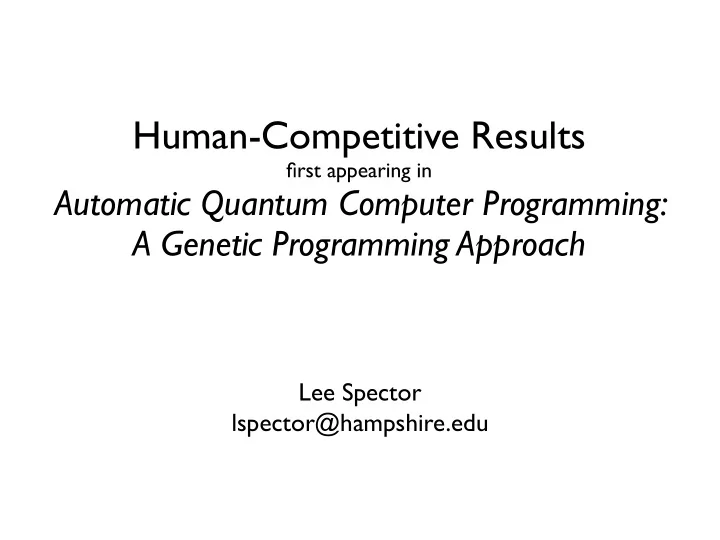

Human-Competitive Results first appearing in Automatic Quantum Computer Programming: A Genetic Programming Approach Lee Spector lspector@hampshire.edu
Outline • Project • Book • Criteria • Results • Claims
Project: Motivation • Quantum computing may provide awesome computational power; e.g. ~2 minutes rather than 5+ trillion years to factor a 5,000 digit number. • New quantum algorithms may support new applications and/or help to answer open theoretical questions. • But discovery of new quantum algorithms is hard! • Goal: automated discovery of new and useful quantum algorithms.
Project: Approach • Use genetic programming to discover new quantum algorithms. • Assess “fitness” via quantum computer simulation. • Various algorithm/genetic encodings for various problem classes.
QGAME Quantum Gate And Measurement Emulator http://hampshire.edu/lspector/qgame.html
Book Automatic Quantum Computer Programming: A Genetic Programming Approach Lee Spector. 2004. Boston: Kluwer Academic Publishers. ISBN 1-4020-7894-3. http://hampshire.edu/lspector/aqcp/
Criteria (B) The result is equal to or better than a result that was accepted as a new scientific result at the time when it was published in a peer-reviewed scientific journal. (D) The result is publishable in its own right as a new scientific result independent of the fact that the result was mechanically created. (D*) Would satisfy criterion D if not for my own prior publication (with coauthors) of different but functionally equivalent evolved quantum programs, which themselves did clearly satisfy criterion D.
Results • 1-bit Deutsch-Jozsa (XOR) problem • 2-bit Grover database search problem • 1-bit OR problem • 2-bit AND/OR problem
1-bit Deutsch-Jozsa (XOR) problem • Determine whether the behavior of a black-box quantum oracle satisfies the XOR property using only one call to the oracle. • Result produced by genetic programming with PushGP.
2-bit Grover database search problem • Determine the location of a single marked item in a 4- element quantum database using only one call to the database access function. • Result produced by genetic programming with PushGP. (Diagram on next slide)
1-bit OR problem • Determine whether the behavior of a black-box quantum oracle satisfies the OR property using only one call to the oracle, with a probability of error no worse than 0.1. • Result produced by genetic programming with PushGP. (Diagram on next slide)
2-bit AND/OR problem • Determine whether the behavior of a black-box quantum oracle satisfies the AND/OR property using only one call to the oracle, with a probability of error no worse than 0.2874. • Result produced by genetic programming with PushGP. AND OR OR ORACLE (0,0) ORACLE (0,1) ORACLE (1,0) ORACLE (1,1) (Diagram on next slide)
Claims • 1-bit Deutsch-Jozsa (XOR) result: B EVIDENCE: Original results (by Deutch, Jozsa, and others) were published as new and significant results. • 2-bit Grover database search result: B EVIDENCE: Original results (by Grover) were published as new and significant results. • 1-bit OR result: B, D* EVIDENCE: The first quantum program solving this problem, which was produced by genetic programming, was published by Barnum, Bernstein and Spector in Journal of Physics A: Mathematical and General . • 2-bit AND/OR result: B, D* EVIDENCE: The first quantum program solving this problem, which was produced by genetic programming, was published by Barnum, Bernstein and Spector in Journal of Physics A: Mathematical and General .
Notes All of the presented results are better than can be achieved with classical computing (even probabilistic computing). They rely on specifically quantum computational effects. The book contains additional human-competitive results (for example, in Section 8.5, “Gate Communication Problems”), but those were previously published before July 1, 2003.
Additional Publications Spector, L., and H.J. Bernstein. 2003. Communication Capacities of Some Quantum Gates, Discovered in Part through Genetic Programming. In J.H. Shapiro and O. Hirota, Eds., Proceedings of the Sixth International Conference on Quantum Communication, Measurement, and Computing (QCMC), pp. 500-503. Princeton, NJ: Rinton Press. Barnum, H., H.J. Bernstein, and L. Spector. 2000. Quantum circuits for OR and AND of ORs. Journal of Physics A: Mathematical and General , Vol. 33 No. 45 (17 November 2000), pp. 8047-8057. Barnum, H., H. J. Bernstein, and L. Spector. 2000. Quantum circuits for OR and AND of OR's. Technical Report CSTR-00-014, Department of Computer Science, University of Bristol, August 2000. Spector, L., H. Barnum, and H.J. Bernstein. 1999. Quantum Computing Applications of Genetic Programming. In Advances in Genetic Programming, Volume 3 , edited by L. Spector, U.-M. O'Reilly, W. Langdon, and P. Angeline, pp. 135-160. Cambridge, MA: MIT Press. Spector, L., H. Barnum, H.J. Bernstein, and N. Swamy. 1999. Finding a Better-than-Classical Quantum AND/OR Algorithm using Genetic Programming. In Proceedings of the 1999 Congress on Evolutionary Computation , pp. 2239 -2246. IEEE Press. Spector, L., H. Barnum, and H.J. Bernstein. 1998. Genetic Programming for Quantum Computers. In Genetic Programming 1998: Proceedings of the Third Annual Conference, edited by J.R. Koza, W. Banzhaf, K. Chellapilla, K. Deb, M. Dorigo, D.B. Fogel, M.H. Garzon, D.E. Goldberg, H. Iba, and R.L. Riolo. pp. 365-374. San Francisco, CA: Morgan Kaufmann.
Recommend
More recommend